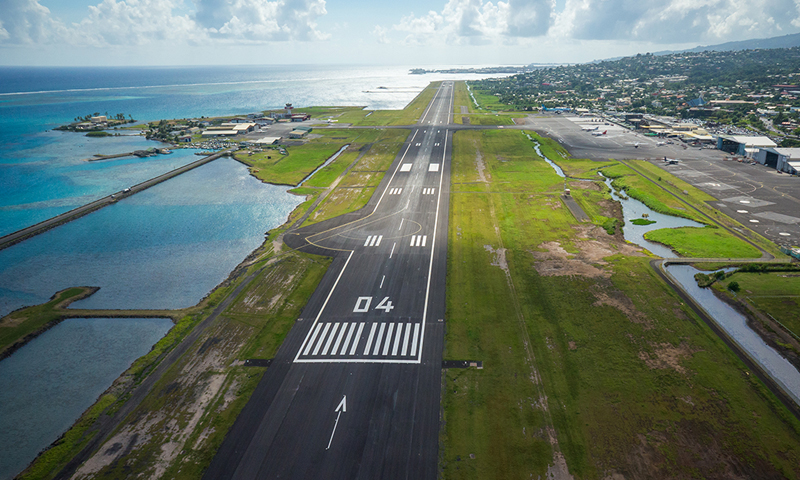Throughout the 1950s, Tahiti was connected to the outside world by boat or seaplanes, notably via the famous “coral route.” This trans-Pacific air route was operated by the TEAL airline, which linked New Zealand to Tahiti with stops in Fiji, Samoa, and the Cook Islands.
In addition to TEAL’s monthly route, foreign travelers had to be transported to Tahiti via Bora Bora, which had the only runway in the Territory. This runway was built in 1942 by the United States to station troops there following their entry into the war against Japan after the attack on Pearl Harbor.
The construction of Tahiti-Faa’a Airport was decided in Paris on May 15, 1957, and was recognized as a public interest the following year.
At the time, building an airport in Tahiti was seen as a solution to various problems, including:
The first construction work began in 1959, involving the creation of an embankment in the Faa’a lagoon area where a seaplane base existed on Motu Tahiri. The project was undertaken by the French Society for Dredging and Public Works, which had just built the runway in Hong Kong.
Two years and 43,000 cubic meters of material were needed for this massive project, which took shape between the shore and Motu Tahiri.
The first part of the runway, 2,000 meters long and 150 meters wide, was completed in 1960. The runway then opened to commercial air traffic, but work continued for six more months to extend the runway to 3,416 meters, allowing jets to serve Tahiti.
The year 1960 marked a turning point in the history of aviation in French Polynesia and the beginning of a new era: the era of tourism.
To date, Tahiti-Faa’a Airport is the only international airport in French Polynesia, which comprises 118 islands spread over an area equal to that of Europe.
It plays a strategic role in ensuring the connectivity of French Polynesia’s populations with each other and the territory with the rest of the world.
Today, it serves around ten international destinations across Europe, North America, Asia, and Oceania.
Tahiti-Faa’a Airport is managed under a concession agreement at the concessionaire’s risk. This concession is currently being reattributed by the State.
Its management was granted in 2010 by the State to Aéroport De Tahiti (ADT), which has invested nearly 8 billion CFP francs in upgrading airport facilities.
Tahiti-Faa’a Airport is the main base for the leading airline, Air Tahiti Nui (ATN), which holds 42% of the international air traffic market share.
The domestic air network includes 46 territorial airports, one military airport (Moruroa), and four private airfields.
The five archipelagos of French Polynesia are primarily served by Air Tahiti through a regular flight program from Tahiti-Faa’a to about forty destinations, thus facilitating the access of remote islands from Tahiti, and more recently by Air Moana, which serves six destinations across three different archipelagos.
Aéroport De Tahiti manages the airports of Bora Bora, Raiatea, and Rangiroa on behalf of the Territory under Temporary Occupation Authorizations until June 30, 2025.
